Menus
- Naked bikes in comparison test
- Ducati Monster 821 Stripe – entry-level model of the series
- Yamaha XSR 900 is based on the MT-09
- XSR 900 with 115 hp at 10,000 revolutions
- Ducati Monster 821 Stripe with the most stable chassis
- MV Agusta Brutale 800 as lively as ever
- All three with adjustable traction control
- Beauty has its price
- Technical data and measured values
- Performance measurements
- MOTORCYCLE scoring
- MOTORCYCLE test result
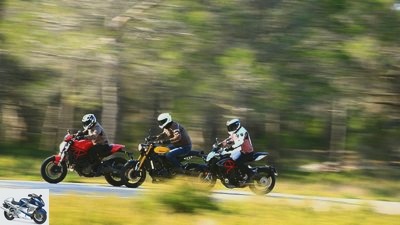
r-photography.info
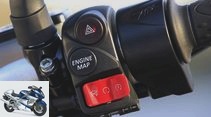
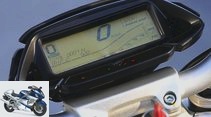
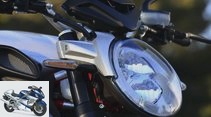
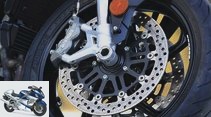
45 photos
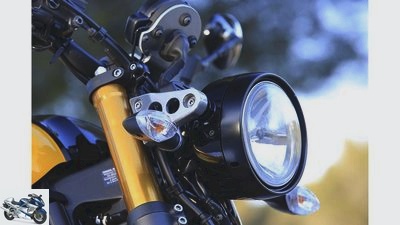
1/45
Yamaha XSR 900.
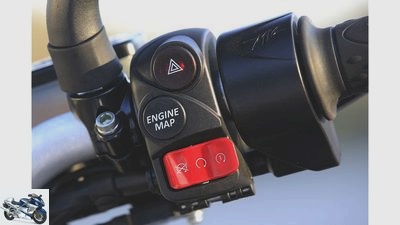
2/45
MV Agusta Brutale 800.
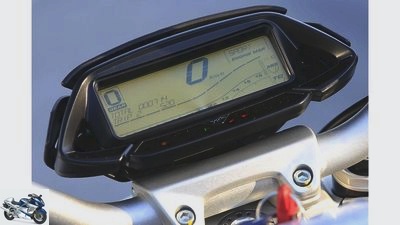
3/45
Small, nice and with good clarity: the MV cockpit. Their fork can be completely adjusted.
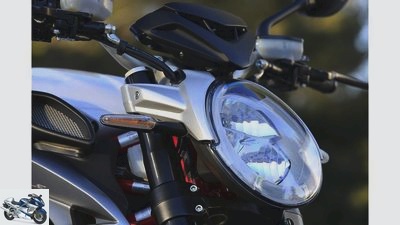
4/45
MV Agusta Brutale 800.
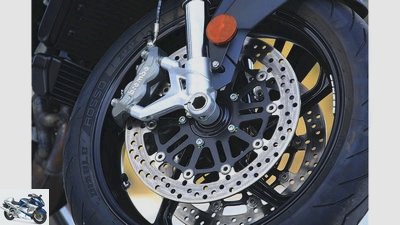
5/45
MV Agusta Brutale 800.
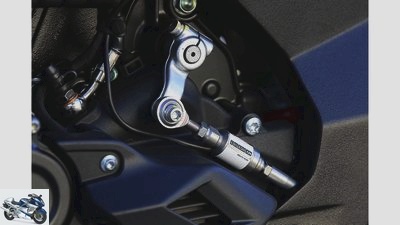
6/45
MV Agusta Brutale 800.
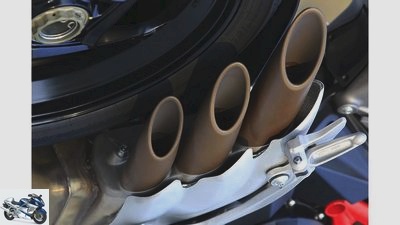
7/45
MV Agusta Brutale 800.

8/45
MV Agusta Brutale 800.
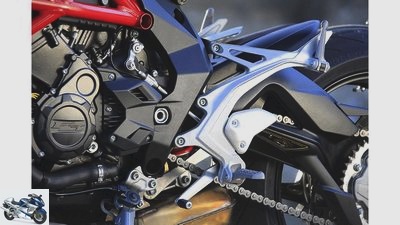
9/45
Art for the eye: the attachment of the pegs.

10/45
Yamaha XSR 900, MV Agusta Brutale 800 and Ducati Monster 821 Stripe in comparison test.
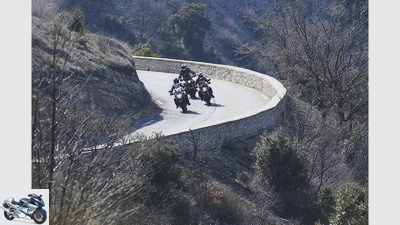
11/45
Yamaha XSR 900, MV Agusta Brutale 800 and Ducati Monster 821 Stripe in comparison test.
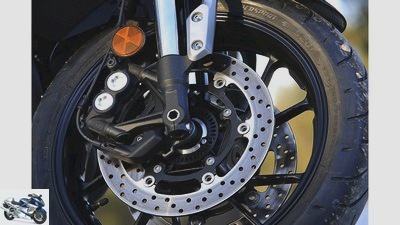
12/45
298 millimeter discs show a fine effect and good controllability, as long as the ABS does not take control and screw up the turning point.
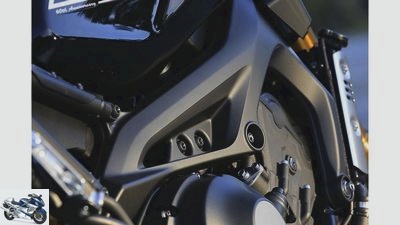
13/45
Yamaha XSR 900.
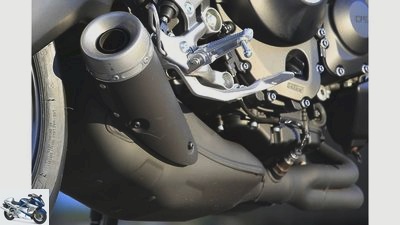
14/45
The short stub exhaust peeps out from under the banana-shaped swing arm.
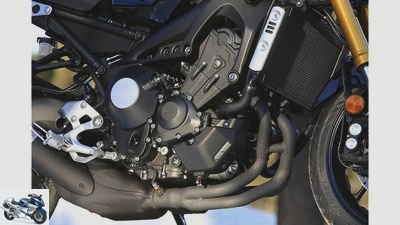
15/45
Exemplary performance development: pushes well below, powerful in the middle and emphatically above.
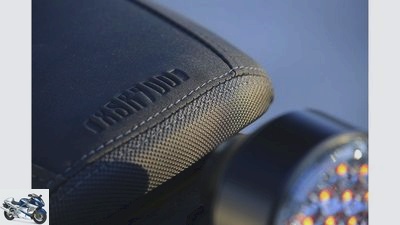
16/45
The seams of the bench are fine.
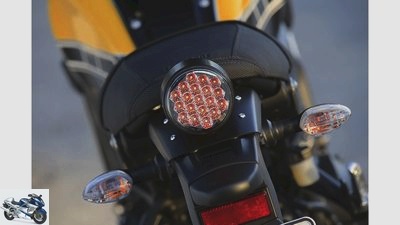
17/45
The LED rear light looks a bit attached.
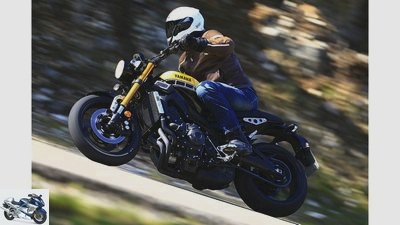
18/45
According to the data sheet, the three-cylinder sends 115 hp to the rear wheel at 10,000 revolutions.
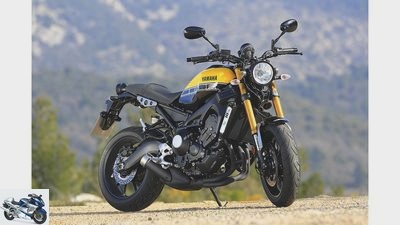
19/45
The Yamaha XSR 900 builds on the current MT-09.
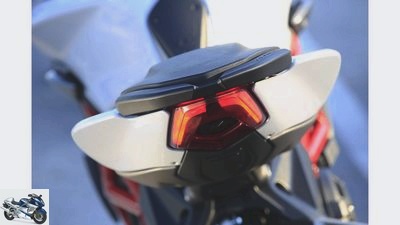
20/45
Art for those who drive behind: the rear.
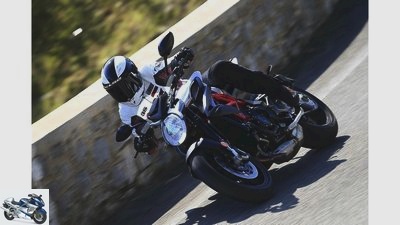
21/45
With 119 hp, the triple now has 9 hp less than last year after Euro 4 homologation. The brutal has lost none of its liveliness.
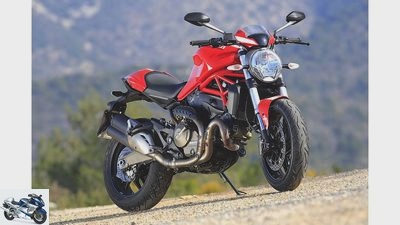
22/45
The monsters have been created in Bologna since 1992.
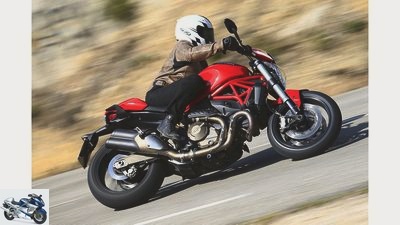
23/45
The design of the Ducati Monster 821 Stripe still follows the lines devised by Miguel Angel Galluzzi.
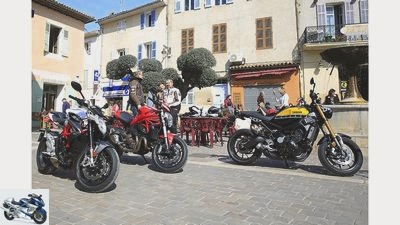
24/45
Yamaha XSR 900, MV Agusta Brutale 800 and Ducati Monster 821 Stripe in comparison test.
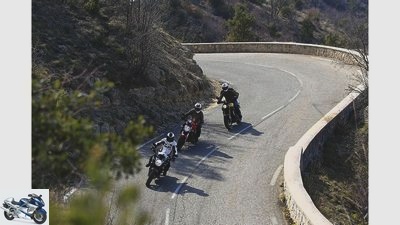
25/45
Yamaha XSR 900, MV Agusta Brutale 800 and Ducati Monster 821 Stripe in comparison test.
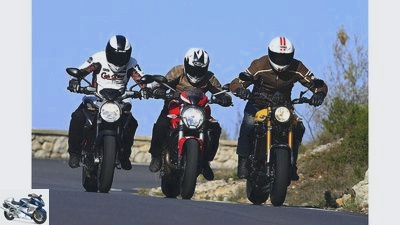
26/45
Yamaha XSR 900, MV Agusta Brutale 800 and Ducati Monster 821 Stripe in comparison test.
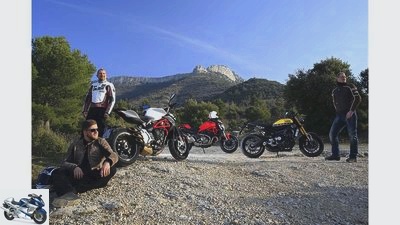
27/45
Let’s see whether the trio can maintain its optical charms even under objective test conditions.
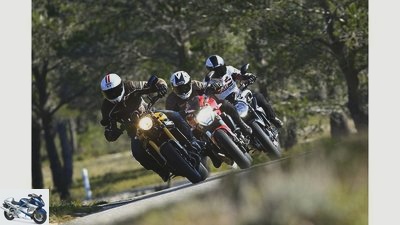
28/45
The three are something for the eye.
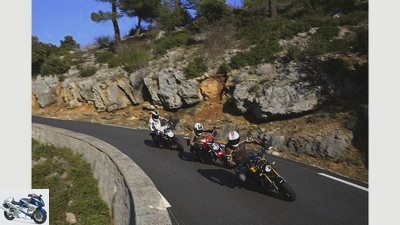
29/45
The comparison test trio consists of the Yamaha XSR 900, MV Agusta Brutale 800 and Ducati Monster 821 Stripe.
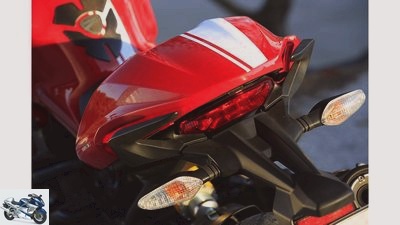
30/45
The rear of the monster looks sleek.
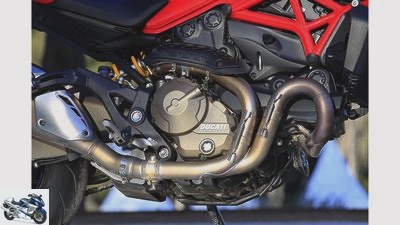
31/45
Reacts not quite as cleanly at the bottom of the speed range.
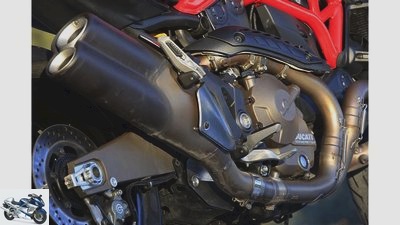
32/45
The Duc has the most stable chassis of the test.
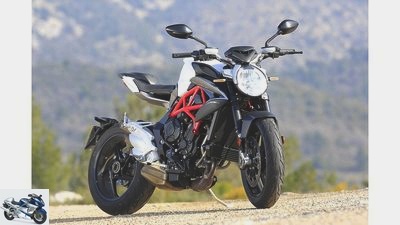
33/45
The layout of the airy, lightly constructed rear does not suggest that there is even a seat in the second row.
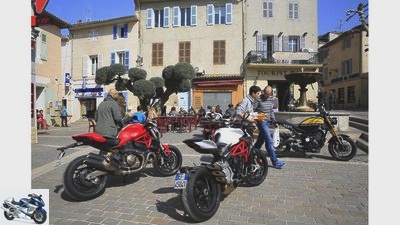
34/45
Radiant men placed under themselves by the sun.
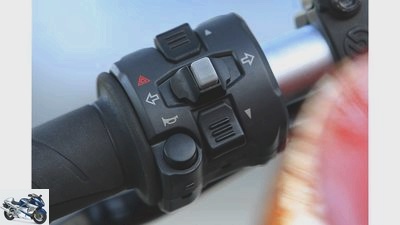
35/45
Ducati Monster 821 Stripe.
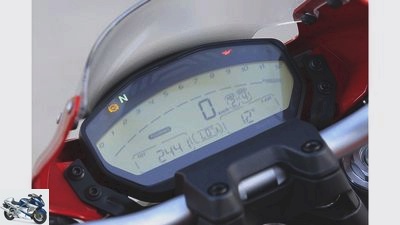
36/45
The monster cockpit also gathers a lot of information. The focus is on speed as a bar and speed as a number.
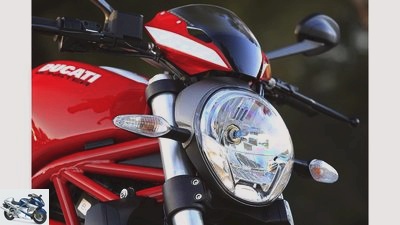
37/45
The tank of the Ducati Monster 821 Stripe holds a good 17.5 liters.
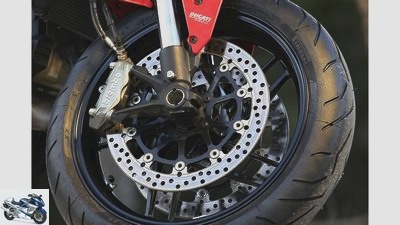
38/45
Ducati Monster 821 Stripe.
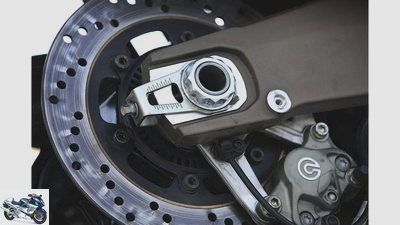
39/45
The fork is fully adjustable, the chain tensioner looks cheap.
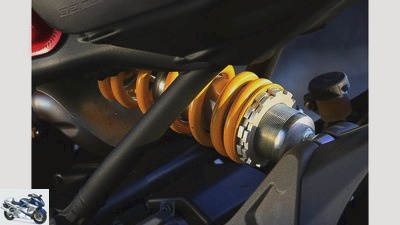
40/45
Ducati Monster 821 Stripe.
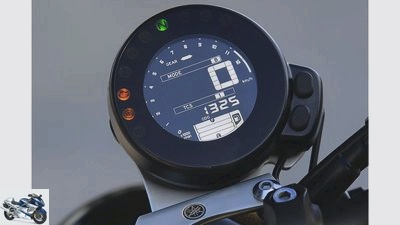
41/45
Little space, lots of functionality: that’s what the cockpit of the XSR 900 offers. Its fork is adjustable in the spring base and rebound.
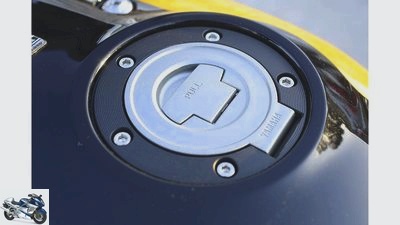
42/45
The tank holds 14 liters.
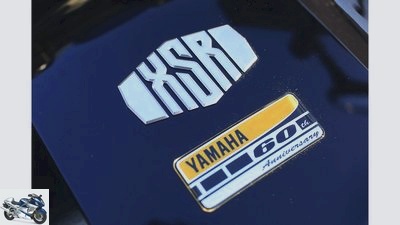
43/45
The 60th Anniversary version proudly flaunts the tuning fork brand’s racing block color scheme.
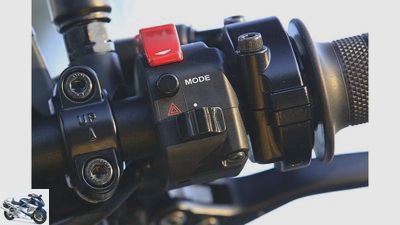
44/45
The drive has good manners across all three driving modes.
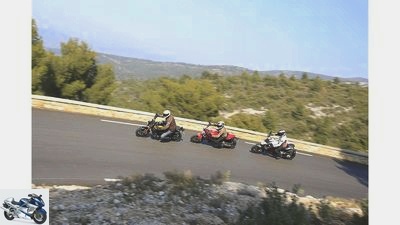
45/45
Three motorcycles for the heart and mind.
Ducati Monster 821 Stripe, MV Agusta Brutale 800 and Yamaha XSR 900
Naked bikes in comparison test
Beguilingly beautiful motorcycles for beguiling country road fun: Ducati Monster 821 Stripe, MV Agusta Brutale 800 and Yamaha XSR 900 try to come as close as possible to this claim in different ways.
"Beauty is an open letter of recommendation that wins hearts for us in advance", Schopenhauer already knew. Anyone who just had a cursory look at the test trio of Yamaha XSR 900, MV Agusta Brutale 800 and D.ucati Monster 821 Stripe throws, has to agree with the philosopher. The three not only want to inspire with pure function, but also flatter the eye, with their color scheme or their formidable lines make you want to walk every meter of the route even before the start.
Buy complete article
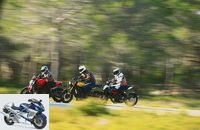
Ducati Monster 821 Stripe, MV Agusta Brutale 800 and Yamaha XSR 900
Naked bikes in comparison test
Monster 821 Stripe maintain their optical stimuli even under objective test conditions? Or is it just the form that blossoms here, pushing the function into the background?
Ducati Monster 821 Stripe – entry-level model of the series
The Ducati Monster 821 Stripe amuses itself with the strong blow of its L-engine over such speculations. Why not? She knows about her history. The two-wheeled beasts have been made in Bologna since 1992. Its design still follows the lines conceived by Miguel Angel Galluzzi.
Even if a lot is new and very different from almost 25 years ago. Air-cooled engines have long since become obsolete at Ducati’s monsters, displacement and performance have grown steadily. The Ducati Monster 821 Stripe as the entry-level model of the Monster series clearly shows this.
Yamaha XSR 900 is based on the MT-09
The MV Agusta Brutale 800 does not look back on so much history of its own. She was born in 675. On this basis, MV later created the sister model with 800 cubic meters, which is now Euro 4-compliant with many updates for testing. The Yamaha XSR 900 has a completely different origin.
Your three-cylinder is based on the current MT-09, which is also homologated according to Euro 4, uses the same chassis construction kit and pairs its technology with an attached, classic-looking dress. This is particularly evident in the 60th anniversary version of the Yamaha XSR 900, which proudly flaunts the tuning fork brand’s racing block color scheme. The origins of the three bikes have thus been clarified. Let’s get back to the initial question: How does it work?
XSR 900 with 115 hp at 10,000 revolutions
The XSR 900 has the best systems for this. One reason is the potent triplet between the black-washed frame tubes. According to the data sheet, it sends 115 hp at 10,000 revolutions to the rear wheel. He spices up this power with exemplary performance, pushes well below, powerfully in the middle and emphatically above. So far there has been criticism mainly for the response behavior and the load changes of the engine from the MT-09. With the Yamaha XSR 900 the prophecies of doom fall silent. The 847 cubic centimeter drive now has fine manners, across all three driving modes. Even in the most aggressive A-gradation it follows the commands of the throttle hand directly, but with previously unknown flexibility. When it comes to acoustic onomatopoeia, he holds back elegantly Japanese, blowing audibly but not loudly from the short stubby exhaust that peeks out from under the banana-shaped swing arm on the right.
Maneuvered on the wide handlebars, the Yamaha XSR 900 willingly follows every impulse to change direction, sweeping corners with good maneuverability without being nervous. A wheelbase of 1440 millimeters and the trio’s slackest steering head angle of 65 degrees give it a lot of stability right up to brisk country road speeds. Only when the speed is really brisk or the asphalt becomes brittle does the chassis move a lot. The spring elements of the XSR 900, with 137 millimeters of travel at the front and 130 millimeters at the rear, do not always act confidently, especially when it comes to damping. A similar picture emerges when braking. If you don’t fly around the corner at the tip of your hand, the system, equipped with two 298 millimeter panes at the front, will spoil you with its fine effect and controllability. But if the ABS takes control of the stopping distance, the rough regulation screwed up the turn-in point. So it’s better to take the whole thing a little slower.
According to the data sheet, the three-cylinder of the XSR 900 sends 115 hp to the rear wheel at 10,000 revolutions.
With the upright sitting position and the extremely relaxed knee angle, nothing hurts with the Yamaha XSR 900 even after many kilometers of country roads, the pleasure trip through spring, which is awakened to life with the first warm rays of sunshine, could go on forever. At least that’s what the driver thinks. It looks different at the back. The passenger pegs are high and far forward.
This forces the passenger into a peculiar, uncomfortable posture with little contact with the driver. And without handles, every strong braking becomes a spontaneous free flight for the pillion passenger upwards. But: With a payload of just 169 kilograms, the carry-on limit is quickly reached. So it’s better to find the distance on your own and empty the 14 liter tank of the Yamaha XSR 900. With a consumption of 4.6 liters per 100 kilometers, it ensures a range of just over the 300 mark when moved around casually.
Ducati Monster 821 Stripe with the most stable chassis
Next comes the Ducati. The tank of the Ducati Monster 821 Stripe holds a good 17.5 liters. With a fuel-saving consumption of 4.6 liters, they are sufficient for ranges of almost 400 kilometers. The Ducati also takes a different approach when it comes to seating comfort. The rider sits low in the motorcycle, even when the seat bench is locked on the highest step at 830 millimeters. The fuel barrel is bulky, and you have to stretch a lot more to the handlebars, which are comparatively low and far forward than on the Yamaha XSR 900. In addition, if the footpegs are higher, the heels have to be spread wide because of the positioning of the exhaust and the passenger pegs. That disturbs. But you can live with it.
After all, the Ducati Monster 821 Stripe with its L-Twin also throws a hefty pound into the scales. After cool nights it initially only reluctantly accepts commands from the right hand and does not react as cleanly as the two triplets to the spontaneous opening of the throttle valve at the bottom of the engine speed range, but at the latest from 3000 revolutions it is open for all jokes. With a really strong thud – the other two go pale with astonishment – he carries horse and rider through the country. From a good 6000 rpm it tenses the muscles again for a second power spring, fires with gusto from turns until it reaches its maximum output of 107 horsepower at 9500 rpm.
The design of the Ducati Monster 821 Stripe still follows the lines devised by Miguel Angel Galluzzi.
The Ducati Monster 821 Stripe supports the engine-side appearance with the most stable chassis of the test. With a wheelbase of 1,480 millimeters, the 821 lies like the proverbial board on the road. In order to keep her calm, she has to sacrifice a few points on the altar of handiness, but what the heck. The little more effort she irons out again with every line made exactly according to the driver’s wishes.
Even if the front tire whines for mercy under the ABS insert, the rear wheel is dancing around nervously: The front remains calm and stable. Great That doesn’t change when a passenger gets on either. The chassis of the Ducati Monster 821 Stripe among the three beauties of the trio also puts it away most loosely. That’s a good thing because it is really easy to travel with on the Ducati. Close to the driver, blessed with plenty of cushion under the stylish cover, the front passenger will find the best conditions for traveling with them.
MV Agusta Brutale 800 as lively as ever
Sitting in the second row on the MV Agusta Brutale 800 is not that comfortable. The fact that there is a decent place at all is surprise enough. The layout of the airy, lightly constructed rear alone suggested otherwise. One or the other could also cite negative views in the performance data of the 2016 brutals. Because: Well, homologated according to Euro 4, the 798 cubic centimeter triple with its 13.3 to one sporty high density has lost some horsepower, according to the factory. 116 ponies ask for exercise at 11,500 rpm. There were 125 in the previous year. But, to anticipate it: the MV has not lost any of its liveliness. The engine even runs as smoothly as never before, only annoying now and then with slight misfires.
Or to put it another way: The 800 now works really well. The individual aisles are quickly quilted up or down using the Quickshifter. Even better than with a coupling aid. And then there is the suction noise. In the airbox, every oxygen molecule is greeted with a joyful handshake before it surrenders to the injected gasoline and helps to push down the 54.3 millimeter pistons. Goosebumps to order. Colleague Johannes Muller even went so far as to describe the MV Agusta Brutale 800 as “sex on wheels”. The Italian triplet emotionalises, but does not terrorize the environment with noise, but reserves the comfortably beautiful soundscape solely for the brutal throttle. The receipt for the omitted use of the wide speed range is still okay. The MV Agusta Brutale 800 burns an average of five liters per 100 kilometers, which means it can travel over 330 kilometers.
All three with adjustable traction control
However, for the MV experience, the pilot has to have a little capacity for suffering. The handlebars are attached even further forward and lower than on the Ducati Monster 821 Stripe, the hands grip – to put it exaggeratedly – directly on the front wheel axle. As with a super sports car, this ensures a lot of transparency, but also requires commitment. Despite the significantly more conservative values for wheelbase (plus 20 millimeters), caster (plus 9 millimeters) and steering head angle (minus 0.5 degrees) than with the predecessor, the MV has enough space in a telephone booth to draw circles around the other two. There is no handier angle. With its fully adjustable chassis, the MV Agusta Brutale 800 also has the right partner on board and is almost indistinguishable during rapid curve dancing.
But only almost: it does not come close to the qualities of the Ducati Monster 821 Stripe in terms of stability. For this, the fork is dampened too softly in this example, despite the completely closed rebound and compression stage, while the tuning of the shock absorber tends towards hard. Bumps penetrate the vehicle noticeably at the rear. And when braking on the last groove, the fork sags, the rear tire only hops slightly over the road as soon as the fine ABS takes over the dosage. The latter could be crisper. Yamaha and Ducati show how it can be done better. This also applies to the adjustable traction controls. They all have three. With the MV Agusta Brutale 800 the function remains hidden, in the Monster and Yamaha XSR 900 they do their job perfectly.
Beauty has its price
MV Agusta charges 12,680 euros for the MV Agusta Brutale 800, Ducati wants 11,790 euros for the Ducati Monster 821 Stripe. It is less, namely 9795 euros, for the Yamaha XSR 900 in the King Kenny look. Beauty has its price.
It is all the nicer that this trio is not the decisive ornament, but rather a successful handshake with the function. Just three motorcycles for the heart and mind.
Technical data and measured values
Yamaha XSR 900, MV Agusta Brutale 800 and Ducati Monster 821 Stripe.
| Ducati Monster 821 Stripe | MV Agusta Brutale 800 | Yamaha XSR 900 | ||
| engine | ||||
| design type | Two-cylinder four-stroke- 90 degree V engine |
Three-cylinder four-stroke- In-line engine |
Three-cylinder four-stroke- In-line engine |
|
| injection | 2 x Ø 53 mm | 3 x Ø 47 mm | 3 x Ø 41 mm | |
| coupling | Multi-panes- Oil bath clutch (Anti-hopping) |
Multi-panes- Oil bath clutch |
Multi-panes- Oil bath clutch (Anti-hopping) |
|
| Bore x stroke | 88.0 x 67.5 mm | 79.0 x 54.3 mm | 78.0 x 59.1 mm | |
| Displacement | 821 cc | 798 cc | 847 cc | |
| compression | 12.8: 1 | 13.3: 1 | 11.5: 1 | |
| power | 79.0 kW (107 hp) at 9250 rpm |
85.3 kW (116 hp) at 11,500 rpm |
84.6 kW (115 PS) at 10,000 rpm |
|
| Torque | 89 Nm at 7750 rpm | 83 Nm at 7600 rpm | 88 Nm at 8500 rpm | |
| landing gear | ||||
| frame | Steel tubular frame, engine is load-bearing | Steel tubular frame with screwed cast aluminum parts | Bridge frame Cast aluminum |
|
| fork | Upside-down fork, Ø 43 mm |
Upside-down fork, Ø 43 mm |
Upside-down fork, Ø 41 mm |
|
| Brakes front / rear | Ø 320/245 mm | Ø 320/220 mm | Ø 298/245 mm | |
| Assistance systems | ABS, traction control | ABS, traction control | ABS, traction control | |
| bikes | 3.50 x 17; 5.50 x 17 | 3.50 x 17; 5.50 x 17 | 3.50 x 17; 5.50 x 17 | |
| tires | 120/70 ZR 17; 180/60 ZR 17 |
120/70 ZR 17; 180/55 ZR 17 |
120/70 ZR 17; 180/55 ZR 17 |
|
| Tires | Pirelli Diablo Rosso II front “D” |
Pirelli Diablo Rosso III | Bridgestone Battlax S 20 “M” |
|
| Dimensions + weights | ||||
| wheelbase | 1480 mm | 1400 mm | 1440 mm | |
| Steering head angle | 65.7 degrees | 65.5 degrees | 65.0 degrees | |
| trailing | 93 mm | 104 mm | 103 mm | |
| Front / rear suspension travel | 130/140 mm | 125/125 mm | 137/130 mm | |
| Seat height ** | 800-830 mm | 835 mm | 830 mm | |
| Weight with full tank ** | 209 kg | 199 kg | 196 kg | |
| Payload ** | 181 kg | 180 kg | 169 kg | |
| Tank capacity / reserve | 17.5 / 2.5 liters | 16.6 liters | 14.0 liters | |
| Service intervals | 15,000 km | 6000 km | 10,000 km | |
| price | 11,790 euros | 12,680 euros | 9495 euros *** | |
| Additional costs | 305 euros | 275 euros | 180 euros | |
| MOTORCYCLE readings | ||||
| Top speed * | 225 km / h | 245 km / h | 210 km / h | |
| acceleration | ||||
| 0-100 km / h | 3.3 sec | 3.6 sec | 3.4 sec | |
| 0-140 km / h | 5.7 sec | 5.7 sec | 5.4 sec | |
| 0-200 km / h | 13.8 sec | 13.0 sec | 12.0 sec | |
| Draft | ||||
| 60-100 km / h | 4.1 sec | 3.2 sec | 3.3 sec | |
| 100-140 km / h | 4.5 sec | 3.6 sec | 3.0 sec | |
| 140-180 km / h | 4.8 sec | 4.5 sec | 4.4 sec | |
| consumption | ||||
| Country road / 100km | 4.6 liters / super | 5.0 liters / super | 4.6 liters / super | |
| Reach country road | 380 km | 332 km | 304 km |
* Manufacturer information; ** MOTORCYCLE measurements; *** Basic model (60th anniversary version 300 euros surcharge)
Performance measurements
Ducati Monster 821 Stripe, MV Agusta Brutale 800, Yamaha XSR 900: performance measurements.
Cubic capacity counts, there is nothing to be shaken with this ancient wisdom. A good example of this is the Yamaha XSR 900. From its little more cubic centimeters, it conjures up performance curves on the parquet that others can only dream of. Regardless of whether it is torque or horsepower, the Yamaha never lets its supremacy be challenged. Noteworthy: Although it is exhaust-gas cleaned according to Euro 4, it does not lose any performance compared to the factory specification, and even slightly exceeds it. That deserves respect. The MV Agusta Brutale 800 proves that this is not that easy under the stricter emissions regulations that are now in force.
116 horses should trot in the lead, 110 have gathered on the test stand. The MV Agusta Brutale had 800 Euro 3-cleaned and still measured 123 PS. So that’s a loss of 13 hp. But that doesn’t detract from the driving experience with the Brutale. The Italian three-cylinder sweeps through the rev range with sheer ease, wants to turn, turn, turn. The other two don’t have that much sporting spirit. The Ducati 821 Monster Stripe develops the most sluggish performance at the bottom, but is almost constant between the competitors from 4000 revs. The extra punch from 6000 rpm is clearly noticeable in the L-Twin from Bologna, which once again creates real fire in the two combustion chambers.
MOTORCYCLE scoring
All three bikes are something for the eye.
| Max points | Ducati Monster 821 Stripe | MV Agusta Brutale 800 | Yamaha XSR 900 | ||
| engine | |||||
| Draft | 40 | 29 | 34 | 35 | |
| acceleration | 40 | 29 | 27 | 29 | |
| Top speed | 30th | 18th | 20th | 15th | |
| Engine characteristics | 30th | 20th | 22nd | 25th | |
| Responsiveness | 20th | 13 | 13 | 15th | |
| Load change | 20th | 14th | 12th | 13 | |
| Smoothness | 20th | 11 | 12th | 14th | |
| coupling | 10 | 7th | 6th | 8th | |
| circuit | 20th | 12th | 11 | 12th | |
| Gear ratio | 10 | 9 | 9 | 9 | |
| Start | 10 | 6th | 8th | 9 | |
| total | 250 | 168 | 174 | 184 |
The Yamaha triplet just rocks, can do almost anything really well. The fact that it drops off at top speed is due to the limited top speed. The Yamaha XSR 900 no longer spins in gears five and six. The MV Agusta Brutale 800 masters this chapter quickly and smoothly, reacting smoothly to gas commands. Only the clutch does not want to be properly metered, noticeably jerks when starting sharply. The Ducati Monster 821 Stripe’s performance is also impressive. Of course, the L-Twin does not reach the level of the three-cylinder in terms of engine characteristics, it needs a few more tours for good concentricity. But that can easily be summarized under character. If only the monsters started a little better now after cold nights.
Winner engine: Yamaha XSR 900
| Max points | Ducati Monster 821 Stripe | MV Agusta Brutale 800 | Yamaha XSR 900 | ||
| landing gear | |||||
| Handiness | 40 | 29 | 34 | 31 | |
| Stability in turns | 40 | 28 | 26th | 24 | |
| Steering behavior | 40 | 28 | 28 | 27 | |
| feedback | 10 | 7th | 7th | 7th | |
| Slope / ground clearance | 20th | 19th | 19th | 17th | |
| Straight-line stability | 20th | 14th | 13 | 13 | |
| Suspension tuning in front | 20th | 12th | 11 | 11 | |
| Chassis set-up at the rear | 20th | 13 | 12th | 12th | |
| Adjustment options undercarriage | 10 | 5 | 6th | 4th | |
| Suspension comfort | 10 | 5 | 4th | 6th | |
| Driving behavior with a passenger | 20th | 14th | 10 | 12th | |
| total | 250 | 171 | 170 | 164 |
Stability wins, that underpins the Ducati. When it comes to cornering and straight-line stability, she collects the most points on her account, and she is also unimpressed by a passenger. Another advantage of the Stripe version: its fork is fully adjustable – in contrast to the normal Ducati Monster 821 Stripe. That gives her the necessary points cushion to win this category. Because the MV Agusta Brutale 800 is close on its heels, scores with its superb handiness, the also huge freedom of lean angle and its fully adjustable chassis front and rear. For the Yamaha XSR 900 it is only enough for third place, it cannot set any highlights in this chapter.
Chassis winner: Ducati Monster 821 Stripe
| Max points | Ducati Monster 821 Stripe | MV Agusta Brutale 800 | Yamaha XSR 900 | ||
| everyday life | |||||
| Ergonomics driver | 40 | 25th | 28 | 29 | |
| Ergonomics pillion | 20th | 8th | 6th | 4th | |
| Windbreak | 20th | 1 | 0 | 0 | |
| view | 20th | 11 | 11 | 13 | |
| light | 20th | 12th | 14th | 13 | |
| Furnishing | 30th | 14th | 11 | 16 | |
| Handling / maintenance | 30th | 19th | 13 | 17th | |
| Luggage storage | 10 | 2 | 1 | 1 | |
| Payload | 10 | 4th | 4th | 2 | |
| Range | 30th | 24 | 20th | 17th | |
| processing |
20th | 14th | 15th | 15th | |
| total | 250 | 134 | 129 | 127 |
And again the monster is ahead. It offers the best place for the pillion passenger and with its small lamp cover, at least in the beginning, something like a windbreak. In addition: With the combination of a large tank and low consumption, the Ducati Monster 821 Stripe achieves the greatest range and has to be the last to the pump. With more tank capacity, the Yamaha XSR 900 would be further ahead, with a better pillion seat anyway. So it is only sufficient to rank two in the chapter everyday life, in which the brutal does very well.
Winner everyday life: Ducati Monster 821 Stripe
| Max points | Ducati Monster 821 Stripe | MV Agusta Brutale 800 | Yamaha XSR 900 | ||
| security | |||||
| Braking effect | 40 | 32 | 32 | 31 | |
| Brake metering | 30th | 27 | 24 | 26th | |
| Braking with a passenger / fading | 20th | 14th | 11 | 13 | |
| Righting moment when braking | 10 | 6th | 7th | 7th | |
| ABS function | 20th | 15th | 14th | 12th | |
| Handlebar slapping | 20th | 12th | 11 | 12th | |
| Assistance systems | 10 | 8th | 6th | 5 | |
| total | 150 | 114 | 105 | 106 |
The brakes and with a formidable effect, almost perfect controllability and almost fade-free: we’re talking about the Ducati Monster 821 Stripe. In addition, your ABS works best, your assistance systems such as traction control work reliably and safely. Noticeable: Particularly when it comes to the ABS control behavior, the Yamaha XSR 900 fails to operate, regulates early and roughly. This can be done better. The MV Agusta Brutale 800 would have been better off with a more controllable braking system and less fading.
Safety winner: Ducati Monster 821 Stripe
| Max points | Ducati Monster 821 Stripe | MV Agusta Brutale 800 | Yamaha XSR 900 | ||
| costs | |||||
| guarantee | 30th | 17th | 15th | 15th | |
| Consumption (country road) | 30th | 21st | 19th | 21st | |
| Inspection costs | 20th | 18th | 9 | 15th | |
| Maintenance costs | 20th | 9 | 9 | 9 | |
| total | 100 | 65 | 52 | 60 |
The main difference is the inspection costs: the Ducati Monster 821 Stripe only needs to be serviced every 15,000 kilometers, the Yamaha XSR 900 to the dealer every 10,000 kilometers, the MV Agusta Brutale 800 even every 6,000 kilometers.
Winner cost: Ducati Monster 821 Stripe
| Max points | Ducati Monster 821 Stripe | MV Agusta Brutale 800 | Yamaha XSR 900 | ||
| Overall rating | |||||
| engine | 250 | 168 | 174 | 184 | |
| landing gear | 250 | 171 | 170 | 164 | |
| everyday life | 250 | 134 | 129 | 127 | |
| security | 150 | 114 | 105 | 106 | |
| costs | 100 | 65 | 52 | 60 | |
| total score | 1000 | 655 | 630 | 641 |
Even if the Yamaha XSR 900 can only make a mark on the engine, it is a really good motorcycle for this circuit.
Price-performance winner: Yamaha XSR 900
MOTORCYCLE test result
Four chapter wins mean the overall victory for the Ducati Monster 821 Stripe.
1. Ducati Monster 821 Stripe
A clear success for the Ducati, four chapter wins don’t lie. The monsters spoiled with fine virtues. An important trump card: the chassis of the Ducati Monster 821 Stripe, which works better than that of the standard Monster.
2. Yamaha XSR 900
The Yamaha XSR 900 shines with its engine, it pays for itself with its concept, in which a retro dress is placed on a long-legged road chassis, but also a few disadvantages. Still a great extension of the MT09 construction kit.
3rd MV Agusta Brutale 800
The MV Agusta Brutale 800 simply turns on, its engine is a giver of joy that smoothes age wrinkles, despite its reduced performance, and works smoothly like never before. Only the costs ensure that the face wrinkles again.
Related articles
-
Comparison test: super sports cars under 1000 cubic meters from MV Agusta, Ducati and Kawasaki
Jahn 46 pictures Jahn 1/46 Kawasaki ZX-6R 636 Jahn 2/46 But the Evo is not alone in this. All three bikes rock the ring during the test. Jahn 3/46 ……
-
Comparison test: KTM Super Duke R against MV Agusta Brutale 990 R
Comparison test: KTM Super Duke R against MV Agusta Brutale 990 R Sporty naked bikes in the test Content of A feast for the senses: The new MV …
-
Yamaha MT-09 and MV Agusta Brutale 800 in comparison test
bilski-fotografie.de 16 pictures bilski-fotografie.de 1/16 MV Agusta Brutale 800 and Yamaha MT-09. www.bilski-fotografie.de 2/16 Typical MV: Hybrid frame …
-
BMW F 800 R, Kawasaki Z 800, MV Agusta Brutale 800 and Yamaha FZ8 in the test
Jahn 29 photos Jahn 1/29 A comparison of four 800 class motorcycles: BMW F 800 R, Kawasaki Z 800, MV Agusta Brutale 800 and Yamaha FZ8. Jahn 2/29 Like…
-
Comparison test: naked bikes BMW, Ducati, Triumph, Yamaha, Kawasaki
fact 66 pictures fact 1/66 If you want a real all-rounder, the Yamaha FZ8 is the right choice. fact 2/66 No trace of saving: Despite the …
-
Comparison test: MV Agusta Brutale 1090 RR and Ducati Streetfighter S
fact comparison test: Italian naked bikes, Ducati Streetfighter S, MV Agusta Brutale 1090 RR MV Agusta Brutale 1090 RR and Ducati Streetfighter S …
-
Comparison test Kawasaki Z 900, MV Agusta Brutale 800 RR Yamaha MT-09 SP
fact / Joachim Schahl 21 pictures fact / Joachim Schahl 1/21 Kawasaki Z 900, MV Agusta Brutale 800 RR and Yamaha MT-09 SP promise undisguised driving pleasure …
-
Comparison test BMW R 850 R against Ducati Monster 800s i.e.
Artist Comparison test BMW R 850 R against Ducati Monster 800s i.e. racoon Washboard In case of doubt, between 70 and 73 hp is worlds apart. Do not you…
-
Ducati Monster 1200, KTM 690 Duke R and Yamaha MT-09 in comparison
www.bilski-fotografie.de 42 pictures bilski-fotografie.de 1/42 Ducati Monster 1200, KTM 690 Duke R and Yamaha MT-09 in the comparison test bilski-fotografie.de …
-
Ducati Monster 821, Aprilia Shiver, BMW F 800 R in comparison test
Arturo Rivas Ducati Monster 821, Aprilia Shiver, BMW F 800 R in the comparison test asphalt sympathizers Even if there is no gray in the photo: The …